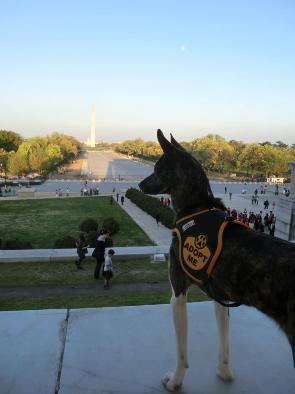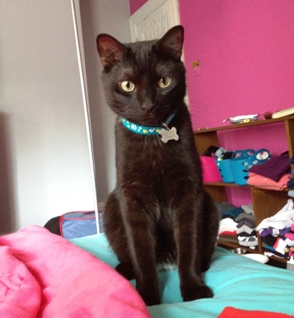Staff and volunteers of the Animal Welfare League of Alexandria work tirelessly to place older and injured animals in “forever” homes
The young woman sat quietly in the sunlit lobby of the Alexandria’s Vola Lawson Animal Shelter, wiping away tears. She held the slacked leash of a large dog, young and muscular. The dog was tense, listening to the sounds of unfamiliar animals in the distance, but stood silent and obedient, close to his owner.
“Why do you have to give the dog up?” asked the man behind the counter.
“He was my dad’s dog,” said the woman, “and we just can’t take care of him anymore.”
While shelters are known for taking in stray and lost animals, it is just as likely that pets in shelters were relinquished by their owners.
The American Society for the Prevention of Cruelty to Animals estimates that approximately 5 million to 7 million companion animals enter shelters nationwide every year and are about evenly divided between those picked up by animal control and those surrendered by their owners.
An unfortunate recent trend has been an increase in the number of older animals being surrendered for adoption, possibly linked to the troubled economy, said Kathy Vellenga, director of adoption programs for the Animal Welfare League of Alexandria, which runs the Vola Lawson Animal Shelter.
Overall, the number of animals entering the shelter began increasing as early as 2006. With older animals, more illnesses crop up near the end of life, and higher veterinary bills may be difficult to manage on a tight budget. In addition, Vellenga has seen animals turned in because of lost jobs and evictions. When an owner has nowhere to go with a long-time pet, the animal ends up at the shelter.
“These people are good pet owners, they are good people, but life happened to them,” said Vellenga. “That’s the hardest part of my job, watching those heartbreaking situations.”
Spreading the Word Through Social Media
Shelters typically face more challenges finding permanent – or “forever” – homes for adult animals, Vellenga said. While kittens and puppies are adopted more quickly, adult animals – especially senior animals 8 years and older – can remain at the shelter for many months.
One solution? Using social media to spread the word about adoptable pets. The Animal Welfare League now regularly uses Facebook, Twitter, YouTube, LinkedIn, and Flickr to provide long-term residents with a little extra promotion, in addition to its web site.
“It’s really great for getting the word out to as many people as possible in a short period of time,” said Patrick Cole, director of communications and outreach. By posting an “adoptable pet of the day” on Facebook, followers can repost a story and get information about an available dog or cat to a potential adopter. Retweets by followers of shelter Twitter posts also help spread the news.
“Because our followers are so dedicated,” said Cole, “they’re willing to share and retweet and really help us expand our reach.”
The league also uses YouTube to help potential adopters see pets in a more natural environment, said Michelle Murray, behavior and training coordinator.
“If we can show them a video of a cat who’s playing or laying in the windowsill of an office,” said Murray, “or a dog rolling around in a swimming pool or playing with another dog, it’s something they are not necessarily going to see just walking through the kennel.”
Since establishing a YouTube channel in January 2011, the league has had more than 7,300 views of its 46 videos promoted.
One of the league’s YouTube sensations is S’mores. S’mores was initially adopted as a puppy by a family in the Alexandria area but was surrendered back to the shelter 10 months later due to what his owners said was severe separation anxiety and destructive behavior. The staff developed a training and medical treatment plan and worked with him for months.
“He was here for a long time,” Vellenga said.
To help improve his adoption prospects, the staff promoted a YouTube video of S’mores at the National Mall being adored by fans. (Watch the video S’mores Goes to Washington.)
“Everybody in the shelter worked together to get this dog to where he needed to be, to be an adoptable dog,” said Murray, “and then finding the appropriate home.”
S’mores was adopted by a family who was willing to adapt to his special needs. Shelter staff continued to work with the family post-adoption to ease the anxious dog into his new environment.
Both Murray and Vellenga agreed that social media has provided them with new ways to increase adoption rates and shorten the length of shelter stays.
“Social media has helped animal welfare tremendously,” Vellenga said.
A “Third Chance” for Injured Animals
Not only are older animals less likely to be adopted than younger, more playful pets, sick or injured animals have even less of a chance of finding permanent homes.
To improve the odds of adoption for all animals that come through the shelter’s doors, the league has set up a special fund – Sarah’s Fund – to pay for costly medical treatments beyond routine screenings, such as amputations, dental extractions or other surgeries. Started in 2003, the fund was named for a dog that came to the shelter in need of surgery.
“We will care for these animals and provide them the medical care that they need,” said Cole.
One recent beneficiary of the Sarah’s Fund is Polo, an adult Pit Bull Terrier mix. Polo jumped from a moving car and severely damaged his right front leg. Unable to pay for surgery, his owner surrendered Polo to the shelter at the end of July. Treatment had been delayed too long to save the dog’s leg, so it had to be amputated.
Sarah’s Fund covered the cost of the surgery, but foster care played the key role in Polo’s recovery – and eventual adoption.
The league has more than 70 volunteers in its expanding network of foster caregivers. While most animals in foster care are underage kittens, the shelter relies on its volunteers to provide temporary homes for sick or injured animals, giving them time to heal. Foster caregivers will also work with animals to correct behavioral problems that might prevent them from being adopted. Depending on an animal’s needs, foster care can last from a few weeks to several months.
Danielle Cook, a volunteer caregiver with the league, has fostered 14 animals from the shelter. “It’s a lot of work, but a lot of fun,” Cook said. A veterinarian technician who is devoted to animal care, Cook recommends everyone try fostering. “It’s very rewarding, helping a life that may not survive on its own if the shelter did not intervene. It makes me feel good about myself, doing something for an animal that doesn’t have a home.”
The league provides all foster volunteers with basic supplies, medical care and any necessary training, depending on the needs of the animal. The shelter staff is in constant contact with foster volunteers, by phone and email, to make sure they have the supplies and support they need, Cook said.
“Foster care is a third chance for the animal,” said Autumn Vigil, foster program coordinator.
An animal’s first chance at life is at birth, explained Vigil. It gets a second chance when it’s brought to the shelter as a stray or surrender. If an animal is sick, injured, or has behavioral problems, the foster program is its third chance.
After surgery in August, Polo moved in with a foster caregiver who spent a month nursing the dog back to health, then worked to promote him to potential adopters.
“He benefited not only from Sarah’s Fund,” said Cole, “but then the foster program as well in order to get adopted.”
In early October, Polo was adopted by a loving family, and now has a little boy as his new best friend. (See a picture of Polo with his new family on the Animal Welfare League of Alexandria’s Facebook page.)
Supporting the Shelter
The League receives about a third of its funding through contracts with the City of Alexandria to provide animal care, control and sheltering services. As part of the contract with the city, the league operates the Lawson Animal Shelter, an open-admission facility that accepts all animals.
The remaining two-thirds of the league’s budget comes from donations.
“We are really lucky… that we have the support of the community,” said Cole. “We are in an animal-friendly area and people are willing to help us. We rely so heavily on donations.”
Information on how you can help the Animal Welfare League of Alexandria is available on their web site at www.alexandriaanimals.org.
Elizabeth M. Grieco
American University
December 12, 2012
![]()
“Unfortunately, we are not going out of business any time soon.”
Kathy Vellenga,
director of adoption programs
Animal Welfare League of Alexandria
Vola Lawson Animal Shelter
4101 Eisenhower Avenue
Alexandria, VA 22304
Phone: 703-746-4774
Email: staff@alexandriaanimals.org
Web site: www.alexandriaanimals.org

The Vola Lawson Animal Shelter.
Photo by Elizabeth M. Grieco.
Lost a pet?
The Animal Welfare League of Alexandria does its best to reunite lost animals with their guardians. Information about the stray animals brought to the shelter is first posted on Pet Harbor, which maintains a searchable list of lost animals currently in shelters around the country. The shelter also advertises on Craigslist. Shelter staff also search lost and found reports and spend time on the phone, calling to see if they have someone’s missing pet. If you’ve lost a pet, visit their web page and start with their tips on finding a lost pet.
S’mores

S’mores at the National Mall in Washington, D.C.
Photo courtesy of the Animal Welfare League of Alexandria.
Freddy
Freddie, a black domestic shorthaired cat, was brought to the Vola Lawson Animal Shelter as an adult stray. Initially very irritable, it quickly became clear to shelter staff that life in a cage was not making Freddie happy. To give him a more natural environment, they moved the grumpy cat into one of the shelter’s offices where he blossomed into an active, playful, affectionate cat. Still not happy being confined in one space, Freddie learned to open doors. “He would hang on the handle of a door until it would open and then scoot out of the room,” said Patrick Cole, director of communications and outreach for the Animal Welfare League of Alexandria. “We’d find him walking down the hallway. He is a very, very smart cat.” Clever Freddie stayed at the shelter for almost a year before making his ultimate escape: recently, he was adopted by a family in the Alexandria area and is living comfortably in his new “forever” home.

Freddy in his “forever” home.
Photo courtesy of the Animal Welfare League of Alexandria.
Polo

Polo, happy and healthy after surgery.
Photo courtesy of the Animal Welfare League of Alexandria.
What are “smalls”?
In addition to cats and dogs, the Alexandria Animal Shelter also has many small animals — or “smalls” — available for adoption. Birds, mice, rabbits, gerbils, turtles, fish, hamsters, chinchillas, snakes, guinea pigs and ferrets are among the shelters current residents. These include a bird named Sweetie Pie, a rabbit named Sputnik, and a turtle named Dude. Visit their web site to view a list of small animals for adoption.
![]()